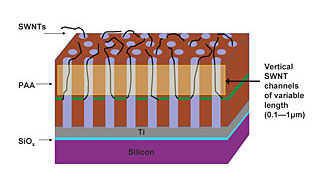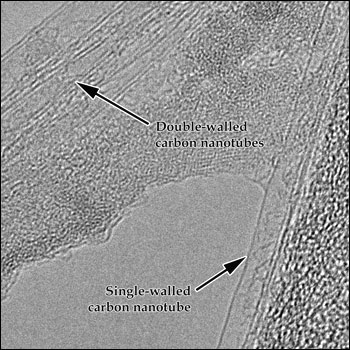
Growing Nanotubes on Silicon a Base for Nanoelectronics
WEST LAFAYETTE, Ind., Aug. 2, 2006 — Engineers have developed a technique to grow individual carbon
nanotubes vertically on top of a silicon wafer, a step toward using
nanotubes to make advanced electronics, wireless devices and sensors by
stacking circuits and components in layers.
 The
technique might help develop a method for creating "vertically
oriented" nanoelectronic devices, the electronic equivalent of a
skyscraper, said Timothy S. Fisher, an associate professor of
mechanical engineering at Purdue University who is leading the work
with Timothy D. Sands, the Basil S. Turner Professor of Engineering.
The
technique might help develop a method for creating "vertically
oriented" nanoelectronic devices, the electronic equivalent of a
skyscraper, said Timothy S. Fisher, an associate professor of
mechanical engineering at Purdue University who is leading the work
with Timothy D. Sands, the Basil S. Turner Professor of Engineering.
"Verticality
gives you the ability to fit more things into the same area, so you can
add more and more layers while keeping the footprint the same size or
smaller," Fisher said. "But before we can even think about using
nanotubes in electronics, we have to learn how to put them where we
want them." 
This
diagram shows the porous anodic alumina template created by Purdue
engineers to grow carbon nanotubes vertically out of tiny cavities on
top of a silicon wafer. The technique might form a foundation for
creating vertically oriented nanoelectronics that can pack more devices
and circuits into a computer chip while keeping the same footprint as
conventional chips. (Image: Birck Nanotechnology Center, Purdue
University)
The engineers first created a thin film
containing two layers of aluminum sandwiching one ultrathin layer of
iron using electron-beam evaporation, a standard process employed in
the semiconductor industry. The engineers then used anodization, a
process that causes metals to oxidize -- like rusting -- to selectively
create tiny cylindrical cavities and turn the film into a porous anodic
alumina template less than 1/100th the width of a human hair. During
the process, an electric field was used to form a precisely aligned
array of nanoscopic holes, turning aluminum into porous alumina, the
oxidized form of aluminum also known as aluminum oxide.
A
mixture of hydrogen and methane gas was then flowed into the template's
holes, and microwave energy was applied to break down the methane,
which contains carbon. The iron layer acted as a catalyst that prompted
the carbon nanotubes to assemble from carbon originating in the
methane, and the tubes then grew vertically out of the cavities.
"You
get a single nanotube in each pore, and that's important because we can
start to think about controlling how and where to put nanotubes to
vertically integrate them for future electronic devices and sensing
technologies," Sands said.
This
picture, taken with a transmission electron microscope, shows carbon
nanotubes that have been grown out of tiny cavities in a porous anodic
alumina template created by Purdue engineers. A layer of iron in the
template acts as a catalyst to grow the nanotubes from methane gas
flowed into the template. (Photo: Birck Nanotechnology Center, Purdue
University)
The team's findings are detailed in a research paper that appeared July 11 in the journal Nanotechnology.
The paper was written by graduate students Matthew R. Maschmann and
Aaron D. Franklin; postdoctoral research associate Placidus Amama;
Dmitri Zakharov, a staff scientist at Purdue's Birck Nanotechnology
Center; Eric Stach, an associate professor of materials engineering;
Sands and Fisher. The research is based at Birck Nanotechnology Center.
"The pores in the template and the nanotubes that grow in the
pores really self-assemble once you set the process in motion," said
Stach, who used two types of electron microscopes to take images of the
nanotubes emerging vertically from the cavities.
The cavities
form within seconds, and the nanotubes take several minutes to finish
growing. The holes vary in width from 30-50 nanometers. A nanometer, or
billionth of a meter, is about as long as 10 hydrogen atoms strung
together.
Carbon nanotubes, which were discovered in the early
1990s, might enable industry to create new types of transistors and
more powerful, energy-efficient computers, as well as ultrathin
"nanowires" for electronic circuits. Reaching that potential promise,
however, won't be possible unless carbon nanotubes can be integrated
with other parts of circuitry and devices, Sands said.
The
experiments at Purdue yielded both single- and double-walled nanotubes,
meaning they are made of either one or two single sheets of carbon
atoms, yielding tubes about one nanometer in diameter.
Researchers
will continue their efforts to understand which conditions are needed
to produce single-wall tubes versus the double-wall variety and to
learn how to produce more of one or the other. Other researchers
previously have made the templates, but the Purdue researchers are the
first to add a layer of iron, which was Maschmann's idea, Fisher said.
"He
was told by many people, including me, that it probably wouldn't work,"
Fisher said. "We were surprised to see that the nanotubes grow from the
sidewall of the hole and then extend vertically."
Early
applications are most likely in wireless computer networks and radar
technology. Long-term uses are possible in new types of transistors,
other electronic devices and circuits, the researchers said.
The work is funded by NASA through the Purdue-based Institute for Nanoelectronics and Computing. For more information, visit: http://news.uns.purdue.edu
/Buyers_Guide/NanoTechnology_Manufacturing_Pte_Ltd/c10033